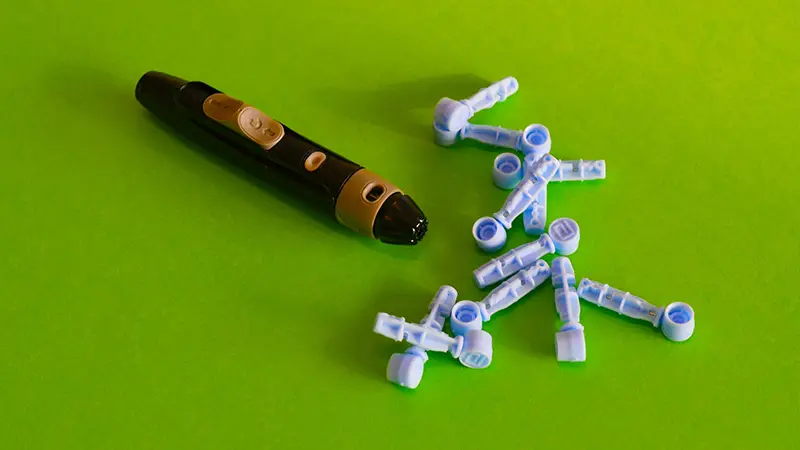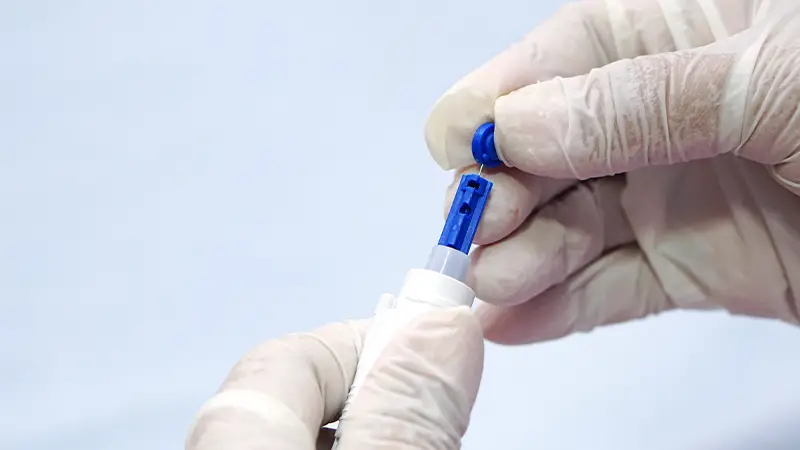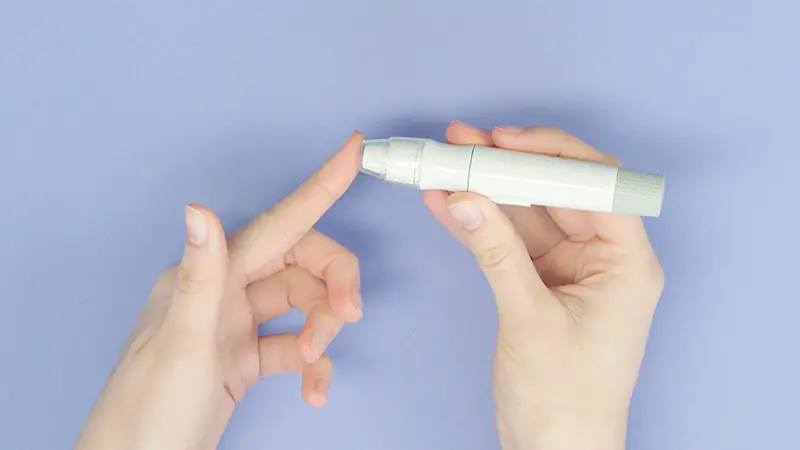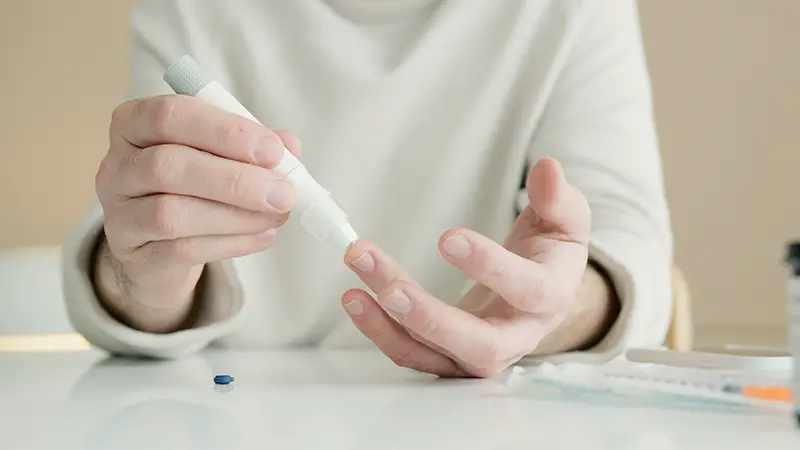In various medical scenarios, pricking your finger to collect a blood sample is a common practice, often done with a lancet—a specialized, sterile device designed for this purpose.
However, life doesn’t always unfold according to plan, and there might be instances when you find yourself needing to obtain a blood sample without access to a lancet.
While this is far from ideal and should be approached with extreme caution, there are alternative methods you can employ in emergencies.
In this blog post, we will explore these alternative methods, emphasizing that they should only be used when there are no other options available.
We will discuss the risks involved and provide step-by-step instructions for safely pricking your finger using alternative tools, such as sterilized needles or scalpels.
Please remember that these methods are not recommended for routine use and should only be considered in dire circumstances.
What Is a Lancet?

A lancet is a small, sharp, pointed instrument or tool that is designed for medical or laboratory purposes.
It is commonly used for procedures that involve puncturing the skin or other tissues to obtain a small sample of blood or to perform various medical tests.
Lancets are typically disposable and are used to minimize pain and reduce the risk of infection when performing tasks such as:
- Blood glucose monitoring: Lancets are commonly used by individuals with diabetes to obtain a small blood sample from their fingertips for blood sugar testing.
- Hemoglobin testing: A lancet may be used to collect a blood sample to measure hemoglobin levels, which can help diagnose anemia and other blood disorders.
- Blood typing and compatibility testing: In laboratory settings, lancets can be used to obtain blood samples for blood typing or compatibility testing.
- Capillary blood gas analysis: Lancets are used to collect blood samples for measuring oxygen, carbon dioxide, and pH levels in the blood.
- Newborn screening: Heel stick lancets are often used to obtain blood samples from newborns for various screening tests.
Lancets are designed to be sterile and are intended for single-use to prevent the risk of contamination or infection.
They come in various shapes and sizes, but they all share the common feature of a sharp point for puncturing the skin with minimal discomfort.
Additionally, lancets are often used in conjunction with devices known as lancing devices or lancet pens, which provide a controlled and consistent depth of penetration when obtaining a blood sample.
This helps ensure accurate and repeatable results while minimizing pain for the patient.
Should I Prick My Finger With A Lancet?

Pricking your finger with a lancet is a medical procedure that should only be done when it is medically necessary and under the guidance of a healthcare professional or as part of a prescribed monitoring or testing routine.
Here are a few situations in which pricking your finger with a lancet might be appropriate:
Blood Glucose Monitoring
If you have diabetes or are at risk for diabetes, your healthcare provider may recommend regular blood glucose monitoring.
This involves using a lancet to obtain a small blood sample from your fingertip and then using a glucose meter to measure your blood sugar levels.
Medical Testing
In certain medical situations, a healthcare professional may need to obtain a small blood sample for diagnostic testing, such as measuring hemoglobin levels, checking blood gases, or conducting other relevant tests.
In such cases, they will use a lancet to safely collect the sample.
Newborn Screening
Heel stick lancets are commonly used for newborn screening tests to collect a small blood sample from a baby’s heel. This is done to screen for a variety of congenital and metabolic disorders.
It’s important to note that pricking your finger with a lancet can be uncomfortable, so it’s essential to follow proper procedures and guidelines to minimize pain and reduce the risk of infection.
Additionally, always use a sterile lancet and dispose of it properly after use, as lancets are meant for single use only.
If you have any concerns about whether you should use a lancet or how to use one correctly, consult with a healthcare professional who can provide guidance and ensure that you are using the lancet appropriately for your specific medical needs.
Self-monitoring or using lancets without a medical reason can be unnecessary and potentially harmful, so it’s essential to follow medical advice and recommendations.
How to Prick Your Finger Without A Lancet?
Pricking your finger without a lancet is not recommended, as lancets are designed for this specific purpose to minimize pain, ensure safety, and reduce the risk of infection.
Attempting to prick your finger without a lancet can be dangerous, and painful, and may result in complications.
However, if you find yourself in a situation where a lancet is not available and you need to obtain a blood sample for a legitimate medical reason, here are some alternative methods.
Please note that these methods are not recommended unless you have no other option, and it’s always best to seek professional medical assistance whenever possible:
Needle and Syringe
Materials Needed
- A sterilized needle
- A sterilized syringe
- Antiseptic solution
- Cotton balls or gauze
Procedure
- Ensure that both the needle and syringe are sterilized. You can do this by boiling them for several minutes or using an autoclave if available.
- Clean the area of your finger where you intend to prick with an antiseptic solution and allow it to dry.
- Carefully and gently insert the needle into the desired location on your fingertip. Be extremely cautious to avoid excessive depth or damage to nerves, veins, or arteries. Aim for a shallow puncture.
- Once you’ve collected the desired amount of blood, carefully remove the needle and syringe from your finger.
- Apply gentle pressure to the puncture site with a sterile cotton ball or gauze to stop bleeding and reduce the risk of infection.
Sterile Blade or Scalpel
Materials Needed
- A sterilized surgical blade or scalpel
- Antiseptic solution
- Cotton balls or gauze
Procedure
- Ensure that the surgical blade or scalpel is sterilized using appropriate methods.
- Clean the area of your finger you intend to prick with an antiseptic solution and allow it to dry.
- Very carefully and with precision, make a small, shallow incision on your fingertip. Avoid deep cuts, and make the incision as clean as possible.
- Collect the desired amount of blood with a sterile cotton ball or gauze.
- Apply gentle pressure to the incision site with a sterile cotton ball or gauze to stop bleeding and reduce the risk of infection.
Needle Prick from a Blood Donation Kit (Last Resort)
In some emergency situations, a blood donation kit might be available. These kits often include a sterilized needle and collection bag.
While not ideal for finger pricking, it can be used in extreme circumstances.
It’s crucial to emphasize that these alternative methods are not recommended and should only be used in emergency situations when no other medical equipment is available.
Using a lancet or seeking assistance from a healthcare professional is the safest and most appropriate way to obtain a blood sample.
Attempting to prick your finger without a lancet can lead to complications, including excessive bleeding, pain, infection, and potential nerve or vascular damage.
Always prioritize your safety and consult with a healthcare provider when medical procedures are necessary.
Important Notes
- These alternative methods should only be used in emergency situations when no other medical equipment is available, and it’s essential to prioritize your safety.
- Using a lancet or seeking assistance from a healthcare professional is always the safest and most appropriate way to obtain a blood sample.
- Attempting to prick your finger without proper equipment can lead to complications, including excessive bleeding, pain, infection, and potential nerve or vascular damage.
- After obtaining a blood sample using alternative methods, it is crucial to seek medical attention promptly to address any potential complications and ensure proper care.
Safety Precautions Regarding Pricking Your Finger

Safety precautions are essential when pricking your finger or having someone else do it for medical purposes, such as collecting a blood sample.
These precautions help minimize the risk of injury, infection, and complications.
Here are safety precautions to follow:
Use a Sterile Lancet or Needle
Always use a sterile lancet or needle designed for single use. Do not reuse lancets or needles. Check the packaging for expiration dates and ensure they are intact.
Hand Hygiene
Wash your hands thoroughly with soap and water before handling lancets or needles. Use hand sanitizer if soap and water are not available.
Clean the Puncture Site
Clean the intended puncture site (usually the fingertip) with an antiseptic swab and allow it to dry before pricking.
Proper Technique
Follow the manufacturer’s instructions for using the lancet or needle. Usually, this involves setting the depth of penetration and ensuring a clean, swift puncture.
Apply even pressure to activate the lancet or needle. Avoid squeezing or mashing your finger.
Dispose of Lancets and Needles Safely
Immediately dispose of used lancets or needles in a puncture-resistant sharps container. Do not recap needles, as this can increase the risk of injury.
Control Bleeding
After pricking your finger, apply gentle pressure with a sterile cotton ball or gauze to stop bleeding. Keep the puncture site elevated if necessary.
Prevent Infection
Avoid touching the puncture site with your hands or any unsterile objects. Do not blow on or lick the puncture site to stop bleeding.
Monitor for Complications
Watch for signs of infection, such as redness, swelling, or pus at the puncture site. If you experience excessive bleeding, consult a healthcare professional.
Seek Professional Help
If you are unsure about how to use a lancet or need to collect a blood sample, seek guidance from a healthcare professional.
If you experience any unusual or severe symptoms after pricking your finger, contact a healthcare provider.
Educate Others
If you are a caregiver or responsible for someone who needs regular finger pricks, make sure they understand these safety precautions.
Store Supplies Safely
Store lancets, needles, and other medical supplies in a cool, dry place, away from children and pets.
By following these safety precautions, you can reduce the risk of injury and complications when pricking your finger for medical purposes.
If you have any doubts or concerns, always consult with a healthcare professional for guidance and support.
FAQs
Is it safe to prick my finger without a lancet if I don’t have one?
Pricking your finger without a lancet is not safe. Lancets are designed for safety and precision. Attempting to use alternative methods can lead to injury, pain, and complications.
Seek professional medical assistance or proper equipment whenever possible.
Can I use a regular sewing needle or safety pin instead of a lancet?
Using a sewing needle or safety pin as an alternative to a lancet is strongly discouraged. These items may not be sterile, and they can cause pain, infection, and damage to your finger.
It’s safer to use medical equipment or seek professional help.
What should I do if I must collect a blood sample without a lancet?
If you have no other option, sterilize a needle and syringe or a surgical blade, clean your finger and the equipment thoroughly, and take extreme care while pricking your finger.
However, this should only be done in emergency situations. Seek professional guidance whenever possible.
Can I reuse a lancet to save money?
Reusing lancets is not recommended. They are designed for single use to maintain sterility and minimize infection risk.
Reusing lancets can lead to contamination and inaccurate results. It’s essential to use a new, sterile lancet each time you need to prick your finger.
What are the risks of pricking my finger without a lancet?
Pricking your finger without a lancet can pose several risks, including excessive bleeding, pain, infection, nerve or vascular damage, and inaccurate results.
It’s crucial to prioritize safety and seek professional assistance or proper equipment when collecting a blood sample.
Wrapping Up
Pricking your finger without a lancet is a last-resort option, best avoided whenever possible.
The safety and precision of medical equipment are paramount when collecting blood samples, and alternative methods carry inherent risks.
We’ve outlined these alternatives to ensure you have some guidance in case of emergencies, but the emphasis remains on seeking professional medical assistance or using proper equipment for this critical task.
Your safety, health, and well-being are of the utmost importance, so prioritize them and use alternative methods sparingly and cautiously, only when there are no other viable options.
Remember, when it comes to medical procedures, it’s always best to rely on trained professionals and the right tools for the job.
Hi, I’m Mark Pattinson and I’m a freelance personal trainer. I’ve been working in the fitness industry for over 10 years especially since I work with diabetes patients and I love helping people achieve their fitness goals. I believe that everyone can benefit from a good workout, and I’ll do everything to make sure you get the most out of your training.
